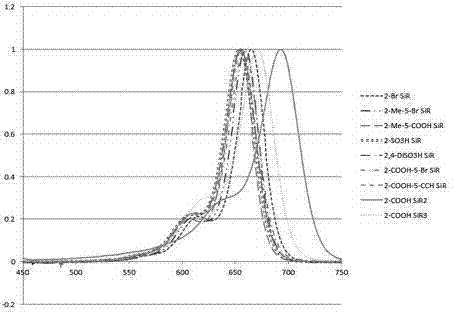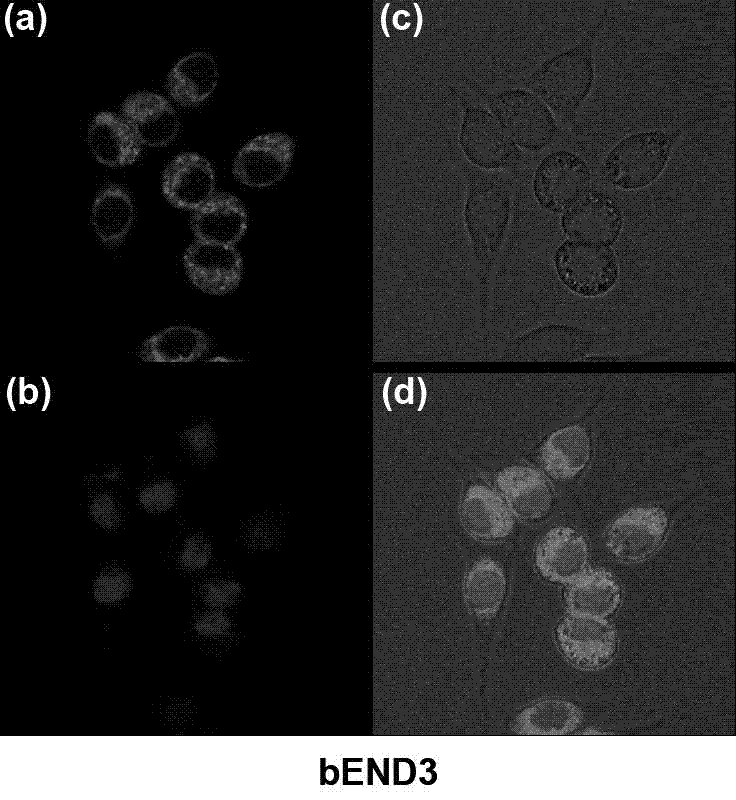Silicon-based rhodamine derivative, preparation method and applications thereof
A technology of silyl-rhodamine and its derivatives, applied in the field of chemistry, can solve problems such as many steps, inability to synthesize substituted silyl-rhodamine, and limited range of substrate selection
- Summary
- Abstract
- Description
- Claims
- Application Information
AI Technical Summary
Problems solved by technology
Method used
Image
Examples
Embodiment 1
[0074]
[0075] In a 500 mL long-necked reaction flask equipped with a magnetic stirrer, 27.376 g (120.0 mmol) of N,N-diethyl-m-bromoaniline was added. Under the protection of argon, 120 mL of anhydrous diethyl ether was added, and magnetically stirred at 0 °C for 5 min. Will n -BuLi 52.5 mL (2.4 M in n- Hexane, 126.0 mmol) was slowly added dropwise to the reaction solution, and after the dropwise addition was completed, the reaction was continued at 0 °C for 2 h. Dissolve 8.8 mL (72.0 mmol) of dimethyldichlorosilane in 30 mL of anhydrous ether, and slowly add it dropwise to the above reaction solution. After the dropwise addition, the reaction was slowly warmed to room temperature and stirred overnight. Add 150 mL of water to the reaction solution, separate the organic layer with a separatory funnel, and extract the aqueous layer with diethyl ether (50 mL 3), combined organic layers, washed once with 150 mL of water, once with 150 mL of saturated NaCl aqueous solution...
Embodiment 2
[0078]
[0079] In a 250 mL long-necked reaction flask equipped with a magnetic stirring bar, add 4.070 g (18.0 mmol) of 1-ethyl-6-bromoindoline. Under the protection of argon, 50 mL of anhydrous diethyl ether was added, and magnetically stirred at 0 °C for 5 min. Will n -BuLi 11.8 mL (1.6 M in n- Hexane, 18.9 mmol) was slowly added dropwise into the reaction solution, and after the dropwise addition was completed, the reaction was continued at 0 °C for 2 h. Dissolve 1.3 mL (10.8 mmol) of dimethyldichlorosilane in 10 mL of anhydrous ether, and slowly add it dropwise to the above reaction solution. After the dropwise addition, the reaction was slowly warmed to room temperature and stirred overnight. 50 mL of water was added to the reaction solution, the organic layer was separated, and the aqueous layer was extracted with ether (30 mL 3), combined organic layers, washed once with 50 mL of water, washed once with 50 mL of saturated NaCl aqueous solution, and washed once...
Embodiment 3
[0082]
[0083] In a 100 mL long-necked reaction flask equipped with a magnetic stirring bar, add 2.738 g (12.0 mmol) of N,N-diethyl-m-bromoaniline. Under the protection of argon, 10 mL of anhydrous diethyl ether was added, and magnetically stirred at 0 °C for 5 min. Will n -BuLi 7.9 mL (1.6 M in n- Hexane, 12.6 mmol) was slowly added dropwise into the reaction solution, and after the dropwise addition was completed, the reaction was continued at 0 °C for 2 h. Dissolve 7.3 mL (60.0 mmol) of dimethyldichlorosilane in 30 mL of anhydrous ether, and slowly introduce it into the above reaction solution. After the dropwise addition, the reaction was slowly raised to room temperature, and reacted at room temperature for 2 hours. The solvent and unreacted dimethyldichlorosilane were removed under reduced pressure to obtain crude SiNCl. Under the protection of argon, 5 mL of anhydrous ether was added to dissolve the crude SiNCl, and the resulting solution was used for future us...
PUM
 Login to View More
Login to View More Abstract
Description
Claims
Application Information
 Login to View More
Login to View More - R&D
- Intellectual Property
- Life Sciences
- Materials
- Tech Scout
- Unparalleled Data Quality
- Higher Quality Content
- 60% Fewer Hallucinations
Browse by: Latest US Patents, China's latest patents, Technical Efficacy Thesaurus, Application Domain, Technology Topic, Popular Technical Reports.
© 2025 PatSnap. All rights reserved.Legal|Privacy policy|Modern Slavery Act Transparency Statement|Sitemap|About US| Contact US: help@patsnap.com



